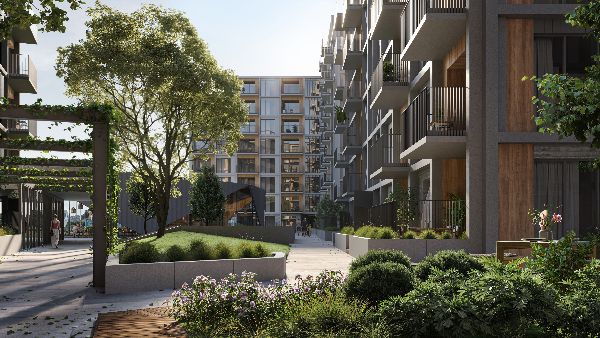Build-to-rent Sector Poised For Growth
Build-to-rent is New Zealand’s latest emerging property asset class designed to service a new generation of New Zealanders who can’t - or don’t want to - own their own home.

Development sector insiders believe build-to-rent (BTR) has huge potential to address New Zealand’s housing supply and affordability issues, but it requires legislative support from the government for the sector to fully realise that potential.
Bayleys head of insights and data Chris Farhi says the rise of BTR in New Zealand fits well with the wider transition to more intensive housing, particularly in the main centres, driven by rising house prices, less availability of greenfield land, and social change. Building consent data shows consents for apartments and townhouses have increased significantly in the past 10 years.
Some BTR stakeholders believe investment in the sector here may have been hampered in part by the government’s 2021 decision to remove interest deductibility on tax for residential investors, and a lack of clarity around how the Overseas Investment Act (OIA) applies to BTR.
In August, Minister of Housing Megan Woods announced new legislation that will exempt new and existing build-to-rent developments from the interest limitation rules in perpetuity but the industry would like the government to go further, particularly when it comes to attracting foreign investment.
Woods says the “2021 interest deductibility rules already had a 20-year exemption for new BTR developments, and the August 2022 announcement was about clarifying that for BTR developments (which typically need a longer time frame to realise returns), while exempting BTR from interest limitation in perpetuity was also a way of reducing speculation on existing housing while attracting different forms of stable, long-term investment like iwi or local superannuation funds”.
Furthermore, Woods says that the government has looked closely at the rules and how they apply to the sector.
“In March this year, the Overseas Investment Office issued guidance regarding the application of the Overseas Investment Act for build-to-rent developments. We expect this can provide the clarity and confidence needed to encourage the institutional investment needed for build-to-rent.”
Property Council New Zealand chief executive Leonie Freeman says more clarity is needed to bring investment into the asset class. “The fact a guidance note was issued is evidence that a problem exists. Our members are quite clear, a ‘guidance’ note is not legally binding.
“We know large institutional investment is poised ready at NZ's gates for BTR. The recent announcement of an asset class is an excellent start by the government but, naturally, we'd like to see next steps too.”
Property Council New Zealand, a long-time proponent of the benefits of BTR to the housing market, is also pushing for access to depreciation for the sector.
“It should be simple to link OIA elements into the asset class, along with the introduction of depreciation. BTR is like a ‘commercial’ type of living and commercial assets already enjoy depreciation benefits so why not BTR too?” says Freeman.
BTR developments are large residential projects designed specifically for rental, rather than individual sale. They are typically multi-unit, high-density living spaces that can include community or co-working areas, as well as leased commercial spaces.
Resident Properties specialises in smaller-scale BTR projects in Auckland’s inner suburbs where many have been priced out of the housing market. Managing director Greg Reidy agrees with the Property Council New Zealand on what’s needed for the sector to take off in this country.
“Build-to-rent businesses are, by nature, large and as a result global. Without opening it up to the rest of the world, BTR may be limited here,” he says. “It needs to be easy for overseas investors to get involved in New Zealand. We’re a small market so it’s not necessarily going to be attractive to overseas investors unless it’s easy.”
Kiwi Property is on track to open its first build-to-rent (BTR) apartments at Sylvia Park in Auckland, in 2024 with future BTR developments intended for LynnMall in west Auckland and Drury, south of Auckland.
Kiwi Property head of communications and investor relations Campbell Hodgetts says with home ownership becoming increasingly unaffordable BTR offers residents convenience, flexibility and stability.
“BTR has the potential to play an important role in helping to ease the housing shortage and offer renters an exciting new way of living.
“It’s still early days, but based on the growth of BTR offshore, we believe the sector has a bright future in New Zealand and we’re looking forward to being part of it,” Hodgetts says.


 Maritime Union of New Zealand: Maritime Union Condemns Threatened Job Losses On Aratere Ferry
Maritime Union of New Zealand: Maritime Union Condemns Threatened Job Losses On Aratere Ferry Science Media Centre: Proposed Increase To Glyphosate Limits – Expert Reaction
Science Media Centre: Proposed Increase To Glyphosate Limits – Expert Reaction Electricity Authority: Welcomes Plan For Boosting Consumer-Supplied Flexibility
Electricity Authority: Welcomes Plan For Boosting Consumer-Supplied Flexibility University of Auckland: How Can Finance Be Harnessed For Good?
University of Auckland: How Can Finance Be Harnessed For Good? Michael Ryan, The Conversation: NZ Budget 2025 - Economic Forecasting Is Notoriously Difficult, But Global Uncertainty Is Making It Harder
Michael Ryan, The Conversation: NZ Budget 2025 - Economic Forecasting Is Notoriously Difficult, But Global Uncertainty Is Making It Harder KiwiRail: Aratere To Retire In August
KiwiRail: Aratere To Retire In August


